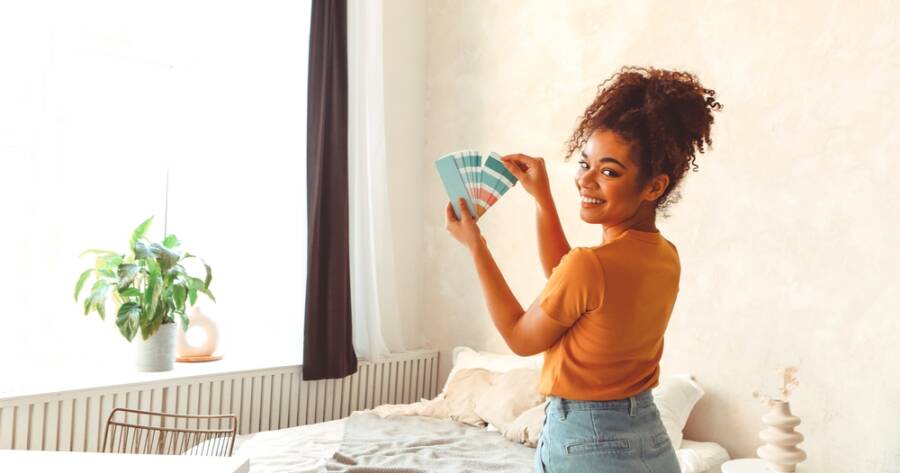Choosing the perfect paint color can completely transform a room’s atmosphere, making it feel spacious, cozy, or energizing. The right choice balances personal style with practical considerations like lighting, furniture, and room function. Even subtle color shifts can impact mood and perception. Understanding color theory, considering the room’s natural and artificial lighting, and experimenting strategically can help anyone select shades that enhance space, harmonize with decor, and create a room that feels both stylish and comfortable.
Consider the Room’s Function
The purpose of a room plays a major role in determining color. Bedrooms often benefit from calming hues, such as soft blues, muted greens, or gentle lavenders, which encourage relaxation and better sleep. Living areas, on the other hand, can support socializing and activity with warmer tones, like soft yellows, peachy neutrals, or even terracotta, creating an inviting and welcoming atmosphere for guests and family alike.
For home offices, consider colors that boost focus and energy. Blues and greens can increase productivity without causing fatigue, while very bright or saturated tones might be distracting during long work sessions. Dining rooms, meanwhile, can benefit from richer tones—deep reds or burnt oranges—that subtly stimulate appetite and conversation. Matching color choices to a room’s function ensures that the space feels appropriate, comfortable, and supportive of the activities that take place there.
Factor in Lighting
Lighting dramatically affects how paint colors appear. Natural light changes throughout the day, shifting hues and brightness. North-facing rooms often have cooler light, making warm tones feel more balanced, while south-facing rooms receive bright sunlight that can intensify certain shades.
Artificial lighting, such as warm or cool LED bulbs, also alters perception. Testing paint samples on different walls under varying lighting conditions is essential. Paint swatches or small sample cans allow you to observe how a color reacts at morning, afternoon, and evening light, helping prevent surprises after the entire room is painted.
Use Color Theory and Coordination
Understanding basic color theory can guide harmonious choices. Complementary colors (opposites on the color wheel) create contrast, while analogous colors (adjacent shades) provide cohesion. Neutrals like beige, gray, and taupe act as versatile bases that can be accented with bolder shades for personality.
Considering furniture, flooring, and décor is also crucial. A wall color should complement existing tones and patterns, enhancing rather than clashing with the space. Layering shades with different intensities and finishes, such as matte walls with glossy trim, can add depth and dimension to a room without overwhelming it.
Test Before Committing
Sampling paint is a practical step often overlooked. Painting small test patches in multiple areas of the room shows how colors interact with light, shadows, and furnishings. Testing allows adjustments without committing to an entire wall.
Experiment with small areas, swatches, or temporary peel-and-stick samples. Observe them at different times of the day and in various lighting. Seeing colors in context prevents costly mistakes and ensures confidence in your final decision. Many paint brands offer sample sizes or tester kits specifically for this purpose, making experimentation convenient and low-risk.
Don’t Be Afraid to Trust Your Instincts
While color theory and design rules provide structure, your instincts bring personality to a room. A color should resonate with your mood and style, evoking emotions that make you feel at home. Sometimes the most unexpected shades—like a deep teal in a bathroom or a soft blush in a hallway—create the most striking and satisfying results.
Balancing expert guidance with personal preference ensures that your space feels authentic and unique. Trusting your creative intuition allows you to take small risks that often lead to beautiful outcomes. After all, paint isn’t permanent; it’s one of the easiest and most affordable ways to refresh your environment and express who you are.
Make Colour a Tool for Transformation
Choosing the right paint color involves a combination of strategy, experimentation, and personal expression. Factoring in lighting, room function, and existing décor, while testing and trusting instincts, helps create a cohesive and inviting space.
With careful planning and deliberate choices, paint can define mood, highlight architectural features, and make rooms feel larger, warmer, or more energizing. A well-chosen color palette transforms a simple room into a space that feels intentional, welcoming, and uniquely yours, demonstrating that color is one of the most powerful tools in home design.

